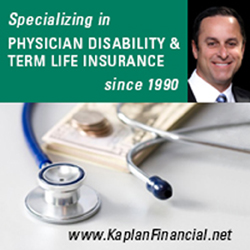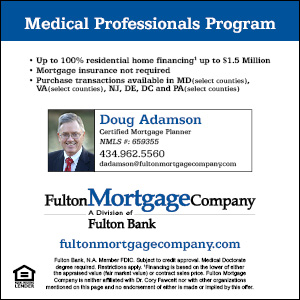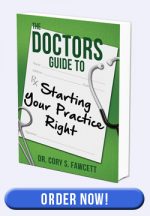(This week’s guest post comes from Andrew at LendEDU)
Becoming a physician requires years of formal education, and that commitment often comes with a hefty price tag. Recent statistics from the Association of American Medical Colleges highlight this reality, estimating that physicians leave medical school with an average of $196,520 in student loan debt.
This number is far higher than other college degree programs, but physicians generally have higher income expectations compared to other programs as well. While they may eventually afford to pay off six-figure debt, not every starting physician can expect to cover both monthly payments, living expenses, and other debt with just a starting salary.
After doing that math, some doctors may
strongly consider a student loan forgiveness program. Student loan forgiveness
is an enticing prospect overall, and there are several programs offered to
phsyicians with student debt. Many of these are listed below. Read on to learn
more about these programs as well as limitations to consider before signing up.
What
Student Loan Forgiveness Options Are Available to Physicians?
A handful of student loan forgiveness options
exist for physicians, depending on the type of work they perform, the type of
debt they carry, and where they live and work. Here are the most common
programs:
Public Student Loan Forgiveness
Public Student Loan Forgiveness, PSLF, is a program enacted by federal law in 2007, available to college graduates with federal student loans who work in certain professions or under specific employers. Physicians may qualify for PSLF if they work for a federal, state, or local government organization, a non-profit that qualifies as a 501(c)(3), or a non-profit that provides qualifying public service. The benefit is that physicians who make 120 qualified payments, either under the standard repayment program or an income-based repayment plan, can have their remaining debt forgiven at the end of the 10-year term.
State-specific Loan Forgiveness
States have also established loan forgiveness programs, specifically catering to medical professionals. For example, Colorado offers the Health Services Loan Repayment Program to physicians who work at either a public or non-profit practice that accepts public aid or provides discounted services to lower income patients. Physicians have to commit to working full-time for three years in a qualified facility, and up to $90,000 is offered for loan repayment. Other states have similar programs with varied requirements for service commitments and differing forgiveness amounts, but there may be salary caps in place.
National Health Service Corps
Under the National Health Service Corps, physicians may qualify for student loan forgiveness if they provide medical care in urban, tribal, or rural communities that meet specific requirements. Up to $50,000 is available to doctors who work full-time at an approved site, and a minimum of two years is required as a service commitment.
What to Consider While Pursuing an SLF Program
Although student loan forgiveness is available
through several different avenues for physicians, there are certain limitations
and implications which must be considered.
Limited
to Practice Within Certain Areas
Many student loan forgiveness programs limit where you can work as a doctor in order to qualify for help with your debt. These locations are often in areas where health care services are lacking, or in low-income or impoverished regions. This would impede your ability to choose where you work after graduation.
Only Federal Loans Are Eligible
Physicians attending medical school may rely on both federal and private student loans to cover the cost of earning their degree. However, only federal student loans are eligible for student loan forgiveness programs. Private loans can be beneficial in closing the gap in funding needed to finish school, but they won’t be forgiven, regardless of where you work.
Repayment Doesn’t Stop
Although student loan forgiveness programs can lead to debt cancellation, some repayment is still required. Even if you qualify for a program that ultimately allows for forgiveness, you must make on-time payments to your federal (and private) student loans. This can be a challenge when you are working in an area with a low starting salary, or you have a significant student loan balance that carries a high minimum monthly payment. You typically have to wait for several years before forgiveness is on the horizon, so having a plan for managing monthly payments is still necessary when you’re just getting started in your career.
May Need to Settle for Lower Starting Income
Qualifying for a
forgiveness program may also mean settling for a pay cut, both initially out of
school and for the years of required service afterward. This can make it
challenging to keep up with minimum student loan payments alongside other
financial obligations or goals. A lower salary at the start of your career may
also have a negative impact on earnings growth over time.
May
Be Locked in for a Set Period of Time
Finally, nearly all loan forgiveness programs have a service commitment, which you must meet to remain eligible. For the public student loan forgiveness, you cannot apply for forgiveness until you have made 120 qualified payments or 10 years. Other state-specific programs may require fewer years of service to qualify, between two and three in many cases, but they do not offer full forgiveness after the first timeframe is met. Full forgiveness eligibility is likely to require several years of working in an eligible area or with a specific organization.
Summing It Up
The good news is that physicians have options when it comes to student loan debt forgiveness. If you are willing to enter a program and fulfil the criteria, then you can have your loans fully or partially forgiven relatively soon compared to other repayment plans. Furthermore, there is no longer a tax bill on forgiven student debt according to the IRS.
Despite the benefits, there are still significant limitations in terms of both career prospects and debt cancellation that should be considered. Before signing up for any program, be sure to do the research on the finer details of a forgiveness program as well as the requirements and implications involved.
If you are ready to stop managing your debt and start eliminating it, pick up a copy of The Doctors Guide to Eliminating Debt and start your journey today. If you have experienced a down side to loan forgiveness programs, I’d love to hear about it in the comments below.
Andrew is a Content Associate for Lendedu – a website that helps physicians, college graduates, small business owners, and many different consumers with their finances. When he’s not working, you can find Andrew hiking or hanging with his cat Colby.









